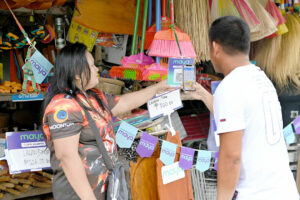




Policy Rate Updates: Double cut finale
 DOWNLOAD
DOWNLOAD

Monthly Economic Update: One for the road
 DOWNLOAD
DOWNLOAD

Inflation Update: Still low, still slow
 DOWNLOAD
DOWNLOAD


BSP stays on track to digitize 50% of all payments this year

THE BANGKO SENTRAL ng Pilipinas (BSP) is on track to achieve its goals to digitize 50% of all retail payments and to bring 70% of adult Filipinos into the financial system this year, its governor said.
BSP Governor Felipe M. Medalla said digitizing 50% of transactions and onboarding 70% of Filipinos is “going quite well.”
“We’re doing quite well thanks to e-wallets (and) the onboarding. More and more Filipinos have accounts and the number of transactions, both the value and volume, is (being) targeted,” Mr. Medalla told reporters on the sidelines of the launch of the United States Agency for International Development’s project for micro, small, and medium enterprises (MSMEs) earlier this month.
Digital payments have been rising as consumers and businesses used more online channels amid mobility restrictions brought by the pandemic.
According to latest data from the BSP, the share of digital payments in the total volume of retail transactions jumped to 30.3% in 2021 from 20.1% a year earlier. The value of payments done online stood at 44.1% of 2021’s total retail transactions, higher than the 26.8% share in 2020.
“For its part, the BSP has introduced several initiatives to facilitate SMEs’ adoption of digital payments and financial services. For instance, our QR-Ph system; QR P2M facility, which allows person-to-merchant payments; and our Paleng-QR Ph Plus, where payments to market vendors, bicycle drivers, and jeepney drivers could now be done through your cellphone,” Mr. Medalla said in his speech.
The volume of merchant payments grew by 43.8% in 2021, while peer-to-peer remittances rose by 268.6%, based on the BSP’s latest data.
“Now, of course, nothing is more frustrating than when your bank does not include one of your credit cards or one of your billers is not on its list of payees. Now that is being answered, as well, with all the other innovations that are happening because of this,” Mr. Medalla added.
In an e-mail interview with BusinessWorld, UNO Digital Bank President and Chief Executive Officer Manish Bhai said digital payments have increased significantly over the past few years.
“This has been driven by the proliferation of smartphones and the widespread availability of internet access, as well as government initiatives to promote digital payments such as the introduction of fund transfer facilities such as PESOnet and InstaPay, the creation of a national QR standard and approval of Digital banking licenses,” Mr. Bhai said.
In 2019, the central bank launched the national Quick Response (QR) Code Standard or QR Ph, which is used for digital P2P transfers and person-to-merchant (P2M) payments.
Under the BSP Circular No. 1055, the central bank required all participating payment service providers to adopt QR Ph for interoperability. As of April 2022, there were 28 and 17 financial institutions participating in the P2P and P2M facilities, respectively.
“In particular, many banks have been working to digitize their processes and offer more digital payment options to customers. This includes the development of mobile banking apps, the implementation of instant payment systems, and the integration of digital wallets and other fintech solutions,” Mr. Bhai said.
Mr. Bhai noted that last year, the Philippines made one of the highest digital payment transactions in Southeast Asia, next to Indonesia and Thailand.
However, Filipinos’ access to financial services is still low, Mr. Bhai said.
“There is still a lot of work to be done if we aim to contribute to BSP’s goal to have 70% of the adult Filipino population have a formal financial account by 2023. Only 10% of the people borrow from formal sector,” he said.
Based on the 2021 Financial Inclusion Survey of the central bank, financial account ownership rose to 56% in 2021 from 29% in 2019. This is equivalent to 42.9 million of Filipino adults.
According to Mr. Bhai, UNO Digital Bank aims to help narrow the gap between the banked and unbanked by leveraging on the country’s high smartphone penetration rate.
THREATS
However, some lenders, especially those in rural areas, may struggle to help digitize payment transactions mainly due to the lack of infrastructure or resources, Mr. Bhai said.
“Additionally, the widespread adoption of digital payments requires a high level of trust and confidence among consumers and merchants, which may take time to develop. Digital organizations are constantly under threat from hackers, and these are compounded when the users are not very vigilant about the potential risks,” he said.
Ensuring the safety and security of systems is one of the highest priorities with UNO, and risks are mitigated by “over investing” in technology, control systems, and talent.
“A strong and supportive regulatory environment, improved infrastructure and more widespread customer education on the benefits of digital payments and transactions, we believe, will pave the way towards the goal of digitizing 50% of retail payments by end of 2023,” he added. – Keisha B. Ta-asan, Reporter
This article originally appeared on bworldonline.com





 By BusinessWorld
By BusinessWorld